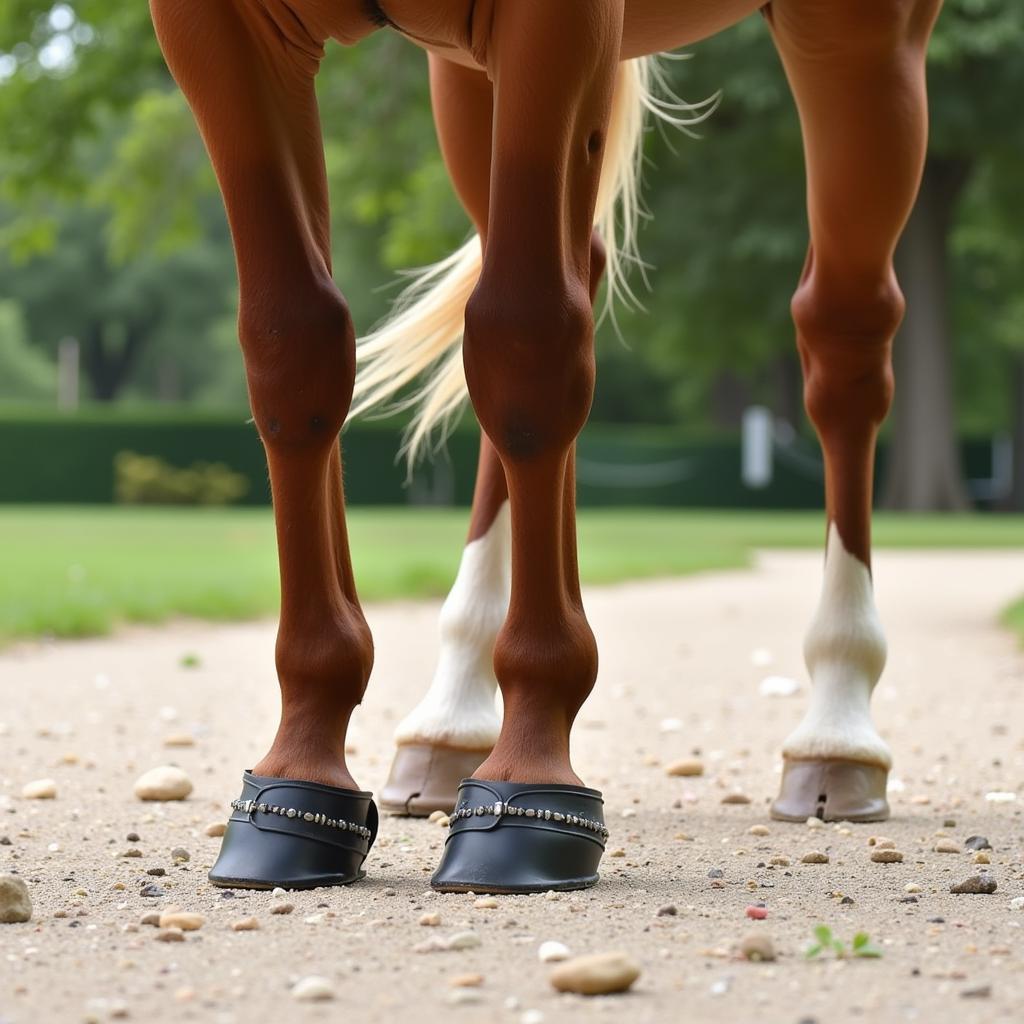Plastic Horse Shoes have become a popular alternative to traditional metal shoes in recent years. They offer a range of potential benefits, from increased comfort to enhanced performance. This comprehensive guide explores the world of plastic horse shoes, delving into their advantages and disadvantages, appropriate uses, and how they compare to other hoof protection options.
Understanding the Benefits of Plastic Horse Shoes
Plastic horse shoes, also sometimes referred to as polyurethane or synthetic shoes, offer several advantages for certain horses and disciplines. One key benefit is their lightweight nature, which can reduce fatigue and improve overall movement, particularly for performance horses. They also offer excellent shock absorption, reducing the concussive forces on the horse’s joints and ligaments. This can be particularly beneficial for horses working on hard surfaces or those with existing joint issues. Furthermore, plastic horse shoes often provide enhanced grip on varied terrains, offering better traction on slippery surfaces and reducing the risk of slipping or sliding. They are also generally easier to apply and remove than traditional metal shoes, often requiring less specialized farrier tools.
After this exciting introduction to the advantages of plastic shoes, you might want to explore different options for protecting your horse’s hooves. Take a look at our selection of horse hoof boot.
 Benefits of Plastic Horse Shoes
Benefits of Plastic Horse Shoes
Plastic vs. Traditional: Weighing the Pros and Cons
While plastic horse shoes offer several benefits, it’s essential to understand their limitations. Compared to traditional metal shoes, they tend to wear down faster, particularly on abrasive surfaces. This can necessitate more frequent shoeing appointments. They also might not be suitable for all disciplines, particularly those requiring maximum grip and durability, such as high-level jumping or reining. Furthermore, plastic shoes may not be appropriate for horses with specific hoof conditions or corrective needs, where the support and adjustability of metal shoes are crucial.
Are you interested in other shoe options for your equine companion? Find out more about composite shoes for horses.
Are Plastic Horse Shoes Right for Your Horse?
Deciding whether plastic horse shoes are the right choice for your horse depends on several factors. These include the horse’s individual needs, the type of work or discipline the horse participates in, and the terrain the horse primarily works on. For example, a horse with sensitive hooves or joint issues might benefit from the added cushioning and shock absorption provided by plastic shoes. A horse used for trail riding on varied terrains might appreciate the enhanced grip. Conversely, a horse competing in high-impact disciplines like jumping would likely benefit more from the durability and grip of traditional metal shoes.
Thinking about the right footwear for riding? Check out our page on shoes for riding horses.
 Horse Trotting with Plastic Shoes
Horse Trotting with Plastic Shoes
Choosing and Caring for Plastic Horse Shoes
If you decide plastic horse shoes are a good option for your horse, it’s crucial to work closely with a qualified farrier. A farrier can assess your horse’s individual hoof conformation and needs and recommend the appropriate type and size of plastic shoe. They can also ensure the shoes are fitted correctly to maximize comfort and performance. Proper care and maintenance are essential to prolong the lifespan of plastic horse shoes. Regular cleaning and inspection can help prevent the build-up of dirt and debris that can contribute to premature wear.
“Proper hoof care is paramount for equine health,” says renowned farrier, Sarah Miller. “Choosing the right shoe, whether plastic or metal, is a crucial step in ensuring your horse’s comfort and well-being.”
Another farrier expert, John Davis, adds, “Plastic horse shoes can be an excellent choice for specific situations, but it’s important to understand their limitations and ensure they are the right fit for the individual horse and its intended use.”
Conclusion
Plastic horse shoes provide a valuable alternative to traditional metal shoes, offering a range of benefits for certain horses and disciplines. By understanding the advantages and disadvantages of plastic horse shoes, and by working closely with a qualified farrier, you can make an informed decision about the best hoof protection strategy for your equine partner.
FAQ
- How long do plastic horse shoes last?
- Are plastic horse shoes more expensive than metal shoes?
- Can I ride my horse on pavement with plastic shoes?
- Are plastic horse shoes easier to apply than metal shoes?
- Can plastic horse shoes be used on all horses?
- What are the different types of plastic horse shoes available?
- How do I clean plastic horse shoes?
Perhaps you’re planning a vacation and want to include some horseback riding. Consider checking out our exciting options for horse riding cancun.
Have you ever considered getting a doll with horse and stable? It’s a great way to share your passion for horses with younger generations!
When choosing horse shoes, there are various factors to consider, including the horse’s breed, age, activity level, and hoof condition.
Some horse owners might also be interested in learning more about barefoot trimming and its potential benefits for horse hoof health.
For additional resources on horse care and hoof protection, explore other articles on our website, Justus Horses USA.
Need help with horse shoeing or other equine care advice? Contact us! Phone: 0772127271, Email: [email protected] or visit us at QGM2+WX2, Vị Trung, Vị Thuỷ, Hậu Giang, Việt Nam. We have a 24/7 customer service team.